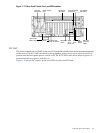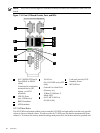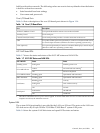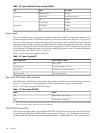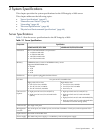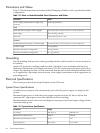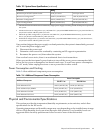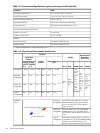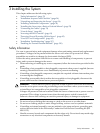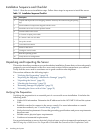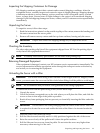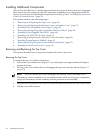
Table 2-3 System Power Specifications (continued)
RatingParameter
25 W per socket25 W per socketMaximum per PCI/PCI-X/PCIe Socket
1056 W (3603 BTU/hr)1095 W (3736 BTU/hr)Maximum Configuration
2
422 W (1439 BTU/hr)432 W (1474 BTU/hr)Minimum Configuration
3
669 W (2283 BTU/hr)685 W (2337 BTU/hr)Typical Configuration
4
1 The infrastructure should be sized such that any single power supply can safely provide all the power required by
the system.
2 Maximum theoretical configuration: (2x) 1.8G/24M CPUs, (24x) 4GB DDRII DIMM memory, (8x) SAS Hard Drives,
(8x) PCI/PCI-X/PCIe added to public I/O cards.
3 Minimum possible configuration: (1x) Itanium 1.8G/24M CPU, (4x) 4GB DDRII DIMM memory, (0x) SAS Hard
Drives, (0x) PCI/PCI-X/PCIeadded to public I/O cards.
4 Half-loaded configuration: (1x) Itanium 1.8G/24M CPU, (12x) 4GB DDRII DIMM memory, (4x) SAS Hard Drives,
(4x) PCI/PCI-X/PCIe added to public I/O cards.
If an overload triggers the power supply overload protection, the system is immediately powered
off. To reset the power supply unit:
1. Disconnect the power cord
2. Determine what caused the overload by contacting an HP support representative
3. Reconnect the power cord, then reboot the system
If an overload occurs twice, there is an undetected short circuit somewhere.
When you use the front panel's power button to turn off the server, power consumption falls
below the low power consumption, but doesn't reach zero. To reach zero power consumption
in “off” mode, either unplug the server or use a power block with a switch.
Power Consumption and Cooling
Table 2-4 lists additional component power consumption.
Table 2-4 Additional Component Power Consumption
Power Consumption
Additional Component
200-240 V ac100-127 V ac
+122 W (417 BTU/hr)+125 W (427 BTU/hr)Each additional CPU
+31 W (106 BTU/hr)+32 W (109 BTU/hr)Each Additional (4x) DIMM
+17 W (58 BTU/hr)+17 W (58 BTU/hr)Each additional SAS HD
+29 W (99 BTU/hr)+30 W (102 BTU/hr)Each additional I/O Card
Physical and Environmental Specifications
This section provides the temperature/humidity requirements, noise emission, and air flow
specifications for the HP server.
Operating temperature and humidity ranges may vary depending on the installed mass storage
devices. High humidity levels can cause improper disk operation. Low humidity levels can
aggravate static electricity problems and cause excessive wear of the disk surface.
Physical and Environmental Specifications 49



